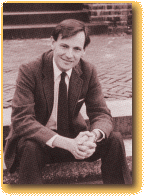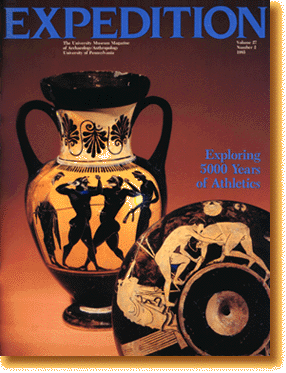

David Gilman Romano, Keeper of Collections of the
Mediterranean Section of the University of
Pennsylvania
Museum, received an A.B. in Art and Archaeology from
Washington University in St. Louis, an M.A. in Physical
Education from the University of Oregon, and a Ph.D. in
Classical Archaeology from the University of Pennsylvania.
The title of his dissertation was "The Stadia of the
Peloponnesos," an architectural study of the ancient Greek
stadium in southern Greece. Since 1982 he has been a
Lecturer in Classical Archaeology at the Museum, teaching
courses in Classical Archaeology and Classical Studies. In
addition, he is Director of the Penn-in-Greece summer
program. His reasearch interests include ancient Greek
athletics, ancient Greek architecture, and ancient city
planning. He has participated in archaeological field work
in Greece at the sites of Corinth and Nemea. At the latter
site, a University of California, Berkeley, project, he
supervised excavation of the late 4th century BC stadium,
the location of one of the four Pan-Hellenic athletic
festivals. He is also an athlete, a long distance runner, as
well as a former physical education teacher and track
coach.


|
This special
website, "The Real Story of the Ancient Olympics" is based
on
"Boycotts, Bribes and Fines"
an article by
Dr. David Gilman Romano
which appeared in the Museum's
Expedition Magazine in 1985
"Exploring 5000 Years of Athletics"

Sorry, this issue is
out of print, but you may wish to order a video of David
Romano's lecture on the ancient Olympics:
The Ancient Olympics:
Athletes, Games and Heroes
videolecture by David Gilman Romano
Institute for Mediterranean Studies
Many of our present-day athletic events are modeled on
those of ancient Olympics, and many of the words used in
antiquity--like stadium, discus, and pentathlon--are still
used today. Dr. Romano discusses the rituals and rules of
the Olympics and explains the various events and customs of
the five-day Olympiad. In addition, he focuses on the
athletes and heroes and the rewards, scandals and politics
that surrounded them! This multi-faceted introduction to the
ancient Olympics includes sculpture, vase paintings and
contemporary scenes of athletic competition. The video,
The Ancient Olympics: Athletes, Games and Heroes is
intended for home viewing by the general public as well as
for use in educational settings. With its interdisciplinary
approach it presents material directly connected to Ancient
History and Religion, as well as Classical Archaeology; in
addition, it is of great value to anyone interested in
athletics, ancient and modern.
1996 VHS; 55 minutes
distributed by the Institute for Mediterranean
Studies
$21.95
|



